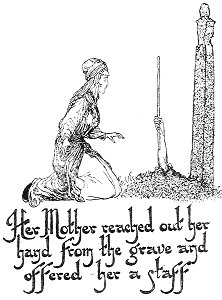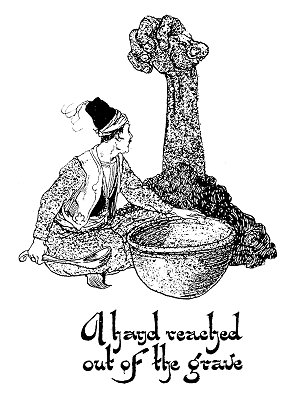| Fable and Folktale Literature 47 Contents:
|
Irvine Valley College Marjorie C. Luesebrink, M.F.A., ProfessorLiterature 47-- Fable and Folktale Assistance for writing the take-home final exam: Here, again, is the prompt for the Take-Home Final Exam: You will be asked to read a folk tale that we have not discussed in class. Then, using the analytical approaches we have covered in the lectures and read about, you will be asked to write a short, organized paper using at least two of the approaches we have studied. You will have three stories to choose among, and you can use any appropriate analytical model, from tale type to psychological. This paper should not be longer than 4 pages. As you will have seen in the directions for completing the Final Exam, you are to first read the stories I have reproduced here for you: "The Legend of the Pink Dolphin," "The Saucy Boy," and "The Fairies' Hill." The directions then go on to ask you to do this: Choose one of these for your response. For ONE story only, using the analytical approaches we have covered in the lectures and read about, write a short, organized paper using at least two of the approaches we have studied (these may include a formal, mythological analysis, a social analysis, a political analysis, a tale-type or motif analysis). This paper should not be longer than 4 pages. Remember, write on only ONE story! The purpose of this exam is to allow you to demonstrate that you can use at least two of the analytical approaches we have studied in class to assess a folk tale. The tales provided each offer somewhat different possibilities, but, in general, you should look for major cosmic, historic, social, or psychological themes, familiar motifs and story types, and elements that might show change or evolution over time. [It's a good idea at this point to review the Syllabus because it has a capsule description of each of the units and the kind of analytical strategies that are being introduced. You can also check the Resources page under each subject area to see if there are useful links!] In order to show you how to approach an assignment such as this, I am going to provide a different story and show how it might lend itself to an organized, short essay. Illustration from a Turkish Folk Tale - where the "hand from the grave" is a helping one!
|
|||||||||||||||
| back to the page for: The take-home, written Final Exam |
this story is from the DL
Ashliman's Page - Aarne-Thompson type 779 The Willful ChildJacob and Wilhelm GrimmOnce upon a time there was a child who was willful and did not do what his mother wanted. For this reason God was displeased with him and caused him to become ill, and no doctor could help him, and in a short time he lay on his deathbed.He was lowered into a grave and covered with earth, but his little arm suddenly came forth and reached up, and it didn't help when they put it back in and put fresh earth over it, for the little arm always came out again. So the mother herself had to go to the grave and beat the little arm with a switch, and as soon as she had done that, it withdrew, and the child finally came to rest beneath the earth. This tale is very, very short - and it is a good one to show you how to start looking at a story that is new to you and to begin examining it and applying the material we have learned in class. First, we notice that this story is attributed to Jacob and Wilhelm Grimm. Since we know from our class study that the Grimm brothers collected folk tales in Northern Europe in the early 19th Century, and that they edited these stories specifically for their middle-class audience, we know that this version is a "literary" version - and that it probably existed long before in oral form. We could look around in Ashliman for other versions which might seem to be earlier and to reflect a less civilized society. So, that gives us one major topic - the Literary Origin of this tale by the Grimm brothers and its possible relation to other, oral tales. Next, we should look for the outstanding "motif" - a material image or event that defines the story. Here, we have this very chilling image/event of the child's arm reaching out of the grave! This looks to be a really defining element, and we can suspect that there might be other stories that use this as a focus theme. A little bit of research shows, in fact, that the Aarne-Thompson Tale-Type index lists the "hand from the grave" as type 779! OK, that gives us a second way to analyze the tale: Tale-Type and Central Motif (in fact, the Ashliman site contains several other tales from Germany, Switzerland, and Poland that contain this grisly feature - and, as you can see from the illustrations, the "hand" comes out of the grave in the folklore of several countries!). Finally, we note that there is a heavy emphasis on guilt. The child is willful and bad, and the mother is also at fault for not disciplining him (Ashliman explains that the sex is not clear in the German version, so a male child is assumed). Because we know this was a "literary tale" from the Grimms, and that they often emphasized strict religious obedience and self-control, we can imagine that the social message here was meant to be very clear: spare and rod and spoil the child! Then, we now have three very good Topics that represent three kinds of analysis we have been practicing this semester: A. Literary Origin B. Tale-Type and Central Motif C. Social Implications Illustration from another Turkish Folk Tale - Where there a "hand from the grave."
|
|||||||||||||||
| Enjoy the Magic! | These topics will form the Body of your short essay. [For more background on how to write the Introduction and Conclusion, you should review the Writer's Workshop section of the Research Help Page.] The Introduction of a essay response should include a Hook in which you restate the question you are answering and give any other framing information. The Thesis should state your overall point of response. The Method statement should list the Topics that you will offer in support of your Thesis. An essay on "The Willful Child" might look like this as a schematic:
Of course, there are many ways to analyze each tale and many different kinds of things you could choose to identify for further investigation. By the same token, each essay will be different, and you are free to create any kind of structure that can clearly represent your own discoveries in reading a story. This guide is to help you see the scope and possible approaches to the Take-Home Final Exam, but not to limit you! Good Luck! back to the page for: The take-home, written Final Exam
|

